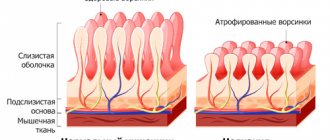Celiac disease, an intolerance to gluten, a protein found in wheat, doesn't just affect young children. Adults also suffer from this. And sometimes they don't know anything about the symptoms of celiac disease. What tests need to be done and how does the treatment work? Celiac disease usually appears in childhood. But it can also appear in adulthood - usually between 35 and 55 years, sometimes later. More often affects women than men. The disease can develop asymptomatically, and then we find out about it by chance. Research suggests that 30% of adults with celiac disease in the first years of life had a mild form, but the disease was not recognized at the time.
Celiac disease: what is it?
Celiac disease should not be confused with a gluten allergy. The symptoms of these diseases are different, and the process of their development is also radically different. What is it?
Celiac disease is a multifactorial disease that results in damage to the villi of the small intestine by gluten protein. The trigger for the disease is gluten consumption. It is this that causes immune cells to attack the small intestine; even a few milligrams of gluten is enough for immune aggression.
The disease is manifested not only by atrophic changes in the mucous membrane of the small intestine, but also by the consequences of impaired absorption. Celiac disease is also called intestinal infantilism, celiac enteropathy, Guy-Herter-Heubner disease, non-toxic sprue.
Stages of celiac disease depending on changes in the intestines:
- Stage 0 (pre-infiltrative) - no changes in the intestinal mucosa;
- Stage 1 (infiltrative) - high number of intraepithelial lymphocytes;
- Stage 2 (hyperplastic) - deepening of the intestinal crypts while maintaining the height of the villi;
- Stage 3 (destructive) - reversible atrophy of intestinal villi (first partial, then total);
- Stage 4 (atrophic) - irreversible atrophic change in the epithelium of the small intestine, often complicated by oncology.
Celiac disease affects people of different races and ages; the first symptoms of the disease can occur both in childhood and in adulthood.
Statistical fact: women are susceptible to intestinal infantilism 2 times more often than men.
Modern medicine cannot accurately answer the question about the cause of celiac enteropathy. However, there is a clear connection with the following pathological conditions:
- heredity (genes HLA - DQ8, HLA - DQ2) - a genetically determined disorder in the breakdown of gluten; if a person has celiac disease, the probability of the disease developing in his child is 1:10 and decreases in subsequent generations;
- allergic factor - sensitization to the gluten peptide gliadin leads to the formation of specific antigens;
- autoimmune reaction - the presence of gluten peptides in the small intestine causes activation of an immunological reaction against the intestinal epithelium;
- adenoviruses - provoke increased sensitivity of the intestinal mucosa to gluten with the simultaneous development of inflammation.
Most often, several factors play a role in the formation of celiac disease. The disease may be preceded by surgery, severe stress, intestinal infection, or rheumatoid arthritis.
Glutenenteropathy often accompanies the following diseases:
- Down Syndrome,
- type 1 diabetes mellitus,
- chronic hepatitis,
- lymphocytic colitis,
- irritable bowel syndrome.
Forms and symptoms of manifestation
Intestinal infantilism is a “many-faced” pathology, often disguised as other diseases. The following symptomatic forms of celiac disease are distinguished:
- Typical - symptoms indicating intestinal damage predominate;
- Hidden - complete absence of symptoms, occasional occurrence of flatulence and diarrhea is possible;
- Atypical - clinical manifestations are not expressed with a predominance of symptoms characteristic of diseases of other organs;
- Latent - in the complete absence of signs of the disease, celiac disease is confirmed by laboratory tests;
- Refractory - with fairly pronounced symptoms and positive laboratory data, the anti-gluten diet does not bring even the slightest relief.
Medicines approved for celiac disease
In the process of treating celiac disease, not only diet, but also medications can be used:
- In severe cases, protein preparations in the form of plasma and albumin and a mixture of amino acids are administered parenterally.
- Additionally, anabolic steroid drugs are prescribed in the form of Phenobolin and Retabolil. They promote protein synthesis.
- Fat emulsions are injected intravenously.
- Enterosgel for celiac disease helps to normalize the microbiological and immune status of the gastrointestinal tract. It is recommended to be used for prevention in the morning and before bed.
- Water and electrolyte disturbances require the use of Panangin and calcium gluconate.
- It is useful to use vitamins A, B, C, E, K and nicotinic acid in therapy.
- To suppress autoimmune mechanisms, glucocorticosteroids are used in the form of Prednisolone and Methylprednisolone.
- Enterol for celiac disease is used to normalize the intestinal microflora. Other probiotics such as Linex, Laktovit forte, Latium can also be used.
- To relieve diarrhea, astringent decoctions of oak bark, pomegranate peels, alder cones, and blueberries are used.
- Smecta, Dermazol, Polyphepan have enveloping and absorbent properties. They can and should also be taken for celiac disease.
- Loperamide and Imodium are used to suppress intestinal motility.
- To reduce the severity of the inflammatory process in the intestinal walls, Pentasa is prescribed for celiac disease.
- Flatulence is combated with carminatives. Relief is achieved with a decoction of dill seeds and antifoam agents, among which Espumisan is popular.
The doctor should select medications taking into account the general condition of the body and the course of the disease.
Symptoms of celiac disease in adults
Although the disease is primarily associated with damage to the mucous membrane of the small intestine and the development of atrophy in it, in adults celiac disease manifests itself with mild symptoms from the gastrointestinal tract. An adult with celiac disease may experience:
- recurrent abdominal pain and diarrhea;
- anemia and weight loss for no apparent reason;
- unreasonable anxiety and irritability, prolonged depression and sudden mood swings;
- talking alone with oneself, performing actions atypical for a person, epileptic seizures;
- chronic fatigue syndrome - dizziness, increased sweating, paroxysmal shortness of breath, weakness and frequent headaches;
- anemia;
- female/male infertility, miscarriages;
- joint and muscle pain (in severe cases, osteoporosis and arthropathy develop, and fractures are common);
- secondary immunodeficiency - stomatitis, glossitis, dermatitis herpetiformis;
- multiple caries;
- constant thirst, every fourth patient develops type 1 diabetes;
- hemorrhages on the abdomen and limbs;
- intestinal bleeding (black stool); in advanced cases, lymphoma develops.
Celiac disease in Israel: prices
Treatment of any disease of any complexity in Israel is much cheaper than in Western Europe and the USA - by 30-50%. At the same time, the level of medical care in Israel is in no way inferior to that in the leading countries of the world.
Prices for the treatment of celiac disease are calculated only after a thorough diagnosis and determination of the severity of the disease. The patient’s vital signs and his body’s response to therapeutic procedures are taken into account. The scope of treatment may vary depending on these factors, so the exact cost of treatment is not calculated in advance. Consultants only provide approximate prices, taking into account the fixed cost of basic diagnostics.
If you want to know the approximate cost of a treatment program for celiac disease, you can contact our medical consultant.
Celiac disease in children and celiac disease in adults: treatment in Israel - differences in the clinical picture
Celiac disease in children manifests itself with characteristic symptoms of the disease and additional signs, including delayed physical development (stunting, low body weight), the development of caries and defects in tooth enamel.
Celiac disease in adults has a more varied clinical manifestation. The characteristic symptoms of celiac disease are complemented by signs characteristic of adulthood, such as arthritis, iron deficiency anemia, pain in the joints and bones, osteoporosis, frequent bone fractures, general weakness, numbness and tingling in the fingers and toes, convulsions, ulcerative lesions of the mucous membrane oral cavity, dermatitis herpetiformis (skin rashes and skin itching). In women, untreated celiac disease leads to menstrual irregularities, infertility, and spontaneous miscarriages.
Celiac disease in Israel: benefits of professional treatment at Top Ichilov
- Top Ichilov has created an entire department dedicated to the diagnosis and treatment of autoimmune diseases of the digestive system, which includes celiac disease. It employs only highly qualified doctors with invaluable experience in this field, who know all the intricacies of the development of the disease and all the ways of treating it.
- Using the latest equipment, the clinic’s gastroenterologists easily and accurately diagnose the pathology of celiac disease and effectively cope with its manifestations, making life easier for patients and significantly improving its quality.
- Drug treatment of celiac disease in Israel is carried out at the highest level using modern medications that quickly eliminate the manifestations and complications of the disease.
- Diet treatment is the main method of treatment and prevention of celiac disease. The diet is prepared individually for each patient. Patients must adhere to a proper and balanced diet for life, excluding the consumption of gluten-containing foods. The diet is developed by the best nutritionists from the gastroenterology department.
- Treatment of celiac disease: the pricing policy is structured in such a way that the patient pays for treatment in stages, upon completion of the procedures. No prepayment and no restrictions on the form of payment. Since prices for treatment are determined on an individual basis, the patient does not have to worry that he will pay for diagnostic or therapeutic procedures that are unnecessary in his case.
- Providing comfortable conditions for treatment and stay in the clinic and the country is the task of the International Department staff, who do an excellent job with it. They professionally perform the functions of a personal medical escort and personal translator, helping patients recover faster and return to their normal lifestyle.
Celiac disease is a very insidious disease, difficult to diagnose, since the symptoms of the disease are nonspecific and are similar to the manifestations of gastrointestinal disorders. Treatment of celiac disease, begun in early childhood, can prevent the development of its complications in adulthood.
Therefore, if you notice problems in your child’s general condition or signs reminiscent of celiac disease, do not waste time and contact the best doctors at the Top Ikhilov clinic. You can get a free consultation by filling out an application for treatment.
- 5
- 4
- 3
- 2
- 1
(6 votes, average: 4.3 out of 5)
Symptoms of celiac disease in children and features of manifestation
Symptoms of celiac disease in children are more pronounced; signs of damage to the intestinal tract predominate. For children under 2 years of age, the following manifestations of the disease are typical:
- foul-smelling diarrhea, large amounts of stool ranging from light yellow to gray and greenish in color;
- often detection of streaks of blood in stool, mucus and undigested fiber (undigested fiber and fatty acids are present in a conventional stool analysis);
- a characteristic sign is that feces do not sink in water and dissolve into pieces;
- nausea, vomiting;
- weight gain is practically absent or minimal, anorexia is possible;
- flatulence and a huge swollen belly, especially noticeable against the background of thin arms/legs;
- tremor of the limbs, psychomotor agitation.
In older children, celiac disease manifests itself:
- constipation alternating with diarrhea (virtually no normal stool);
- loss of appetite or, conversely, constant hunger;
- anemia;
- low weight, short stature;
- various allergic reactions (diathesis, urticaria, hay fever);
- osteoporosis, rapid destruction of baby teeth;
- alopecia;
- autism.
How to treat the disease:
Naturally, this means eliminating all gluten-containing foods from your diet. This is salvation. If it does not enter the body, it means there is no inflammation and no responses to it. 3-5 years are enough for the intestinal mucosa to recover. All manifestations in a person disappear.
What you need to know about treatment:
This will only help if you eliminate gluten from your diet 100%. How much hidden gluten is in products? Manufacturers do not write warnings about this on product packaging.
Treatment is still prescribed. For manifestations of osteoporosis, patients take calcium. If the hemoglobin level is low, use iron supplements. For diarrhea, the intestinal microflora is restored.
Let me remind you that after 100% exclusion of gluten-containing products, the problem gradually disappears.
Nowadays, special enzymes are being developed to destroy gluten before it has time to cause harm to the body. Other drugs should prevent it from penetrating into the intestinal wall.
Developments are underway to create antibodies that can prevent an immune response. All this may happen in the future, but you need to live now and take the necessary measures. Don't think that if you've been doing well on your diet for a long time, you can break it.
The aggravation will come immediately, the disease will return. For the rest of your life, at least until effective drugs are available, you will have to adhere to a strict rule - a 100% gluten-free diet. Never self-diagnose yourself or get treatment “on the Internet.” I am only providing general information about the disease.
No doctor in the world can diagnose you just based on your story and initial examination. We need tests and examination. Only everything together will allow the doctor not to make a mistake, and you to recover. It is not at all difficult to undergo a gastroscopy with a biopsy of the duodenum to put an end to your torment. This procedure is done with an endoscope.
The test results will come back and you will be able to start treatment, but only as prescribed by your doctor. Now do you understand what kind of disease this is, celiac disease?
I wish everyone good health!
Best regards, Svetlana E.
Diagnosis of celiac disease: tests and instrumental studies
To make a diagnosis of celiac disease, a unified picture of the patient’s complaints and diagnostic data is necessary. The disease is indicated by:
- the patient’s appearance - pale skin, problems with height and weight, periodic hemorrhages, etc.;
- anamnesis - patient complaints;
- improvement when following a gluten-free diet;
- scatology - a large amount of soaps, fatty acids in feces;
- stool examination for occult blood;
- biochemistry - hypoalbuminemia/hypoproteinemia, low concentration of fats and cholesterol, lack of calcium and phosphates;
- X-ray - seoporosis, intestinal dyskinesia and clearly defined horizontal levels in the intestinal loops;
- Ultrasound of bones and abdominal cavity;
- fibrogastroduodenoscopy (performed before prescribing a gluten-free diet);
- biopsy of the intestinal mucosa - assessment of the degree of atrophy according to the Marsh system;
- serological test for celiac disease - detection of antigliadin (low sensitivity), antireticulin antibodies and IgA to endomysium.
Celiac disease in Israel: modern treatment in Top Ichilov
Celiac disease develops due to intolerance to one of the components of gluten. Gliadin is found in cereals and foods made from grains.
In Israel, specialists in the treatment of celiac disease have developed a diet and diet that is most suitable for patients with this disease. The result of following a gluten-free diet is the restoration of the mucous membrane of the small intestine and the process of absorption of nutrients. Multivitamin complexes and minerals must be prescribed in order to compensate for their deficiency in the body. In the case of a pronounced inflammatory reaction in the small intestine, the patient is prescribed treatment with steroid drugs.
Today, many food manufacturing companies produce special products that do not contain gluten; the packaging of such products must be marked in the form of a crossed out ear of wheat.
Treatment of celiac disease in Israel is aimed at creating an individual diet for each patient.
- Patients with celiac disease are advised to exclude from their diet foods made from wheat, rye, semolina, barley, spelt, and bulgur.
- You cannot eat products that are not labeled with a crossed out spike: beer, bread and bakery products, confectionery, oatmeal and corn flakes, pasta products, meat and seafood substitutes, semi-finished meat products, ready-made sauces and soups.
- You can eat products made from buckwheat, corn, rice, rice, soybean, corn flour, tea and coffee, potatoes and legumes, fruits, vegetables, fresh meat, fresh fish, dairy products, gluten-free alcoholic drinks.
- Surgical methods for treating the gastrointestinal tract
Treatment of celiac disease in adults and children
The treatment complex for celiac disease in adults, as well as in children, includes drug therapy aimed at eliminating the symptoms of the disease and a lifelong diet.
Drug treatment for celiac enteropathy:
- Antidiarrheal drugs;
- Fighting vitamin deficiency - multivitamin products;
- Treatment of anemia - folic acid, vit. B12, iron supplements;
- Restoring bone density - vit. D, calcium supplements;
- As prescribed by an allergist-immunologist, antihistamines, immunocorrectors;
- Psychotropic drugs (only as prescribed by a psychotherapist!);
- In severe cases, corticosteroids and intravenous infusions of nutrient solutions.
Under no circumstances should patients with celiac disease take tablet forms of medications. coated (contain gluten), and liquid forms containing malt!
Nutrition for Celiac Enteropathy
If celiac disease is detected, the patient is prohibited from consuming the following foods for life:
- grains - wheat, barley, rye, oats;
- all flour products - bread, pasta, cookies, pastries;
- products with stabilizers, emulsifiers, dyes, etc.;
- semi-finished meat/fish products, sausages, sausage, imitation crab sticks;
- ice cream, yogurts, mayonnaise, margarine and various pastes;
- dry soups, bouillon cubes;
- some types of tea, cocoa drinks, coffee (see composition);
- kvass, some types of alcohol.
It is worth avoiding the elementary entry of gluten into the intestines of a patient with celiac disease during cooking through cutting boards, etc.
It is completely safe to use:
- meat, fish, poultry;
- dairy products and eggs;
- buckwheat, rice, corn, legumes;
- fruits and vegetables.
When purchasing products in a store, you must read their composition every time, since even when some of them are processed (for example, grinding peas), gluten may appear, which is indicated on the package.
Forecast
With timely diagnosis of celiac disease and its comprehensive treatment, the prognosis is favorable. A gluten-free diet has an effect after just 3 weeks.
However, restoration of the intestine at the microscopic level (provided that atrophy is reversible) occurs after 2-2.5 years of a strict diet.
Life expectancy does not decrease, and restrictions relate exclusively to nutrition. Only in advanced cases are complications possible, often life-threatening:
- Ulcerative lesions of the small intestine;
- Development of refractory celiac disease;
- Infertility;
- Osteoporosis;
- Oncology of intestines, stomach, lymphoma;
- Mental pathology.
Cough medicine for celiac disease
MEDICINES CONTAINING FLOUR - Aerovit tablets, coated;
— Glutamic acid tablets, coated 0.25; — “Dekamevit” film-coated tablets; — Ibuprofen tablets, film-coated 0.2; — “Kvadevit” tablets, coated; — Lithium carbonate tablets, coated 0.3; — Methionine tablets, film-coated 0.25; — Pentoxyl tablets, coated 0.2; — Dynesin tablets, film-coated 0.1; — Bisacodyl 5 mg tablets — Cotrimoxazole 120, (480, 960 mg) tablets — Codeine tablets — Dexamethasone tablets — Diclofenac sodium tablets — Digoxin tablets — Fenistil tablets — Phenobarbital tablets — Flagyl tablets — Furosemide tablets — Halopiridol tablets — Imovan tablets — Paracetamol for children 60 mg - Metronidazole tablets - Oxazepam tablets - Propranolol tablets - Pyridoxine chloride 50, 10 mg tablets - Spironolactone tablets - Theophylline tablets - Trazicor tablets - Triamterene tablets - Valerian tablets - Vitamin E tablets 4. Gluten is contained in the following drugs! Film-coated tablets: • Aerovit, • Glutamic acid, • Decamevit, • Ibuprofen, • Kvadevit, • Lithium carbonate, • Methionine, • Pentoxyl, • Dinesin. Acetylsalicylzuur cardio 80 PCH, dispergeerbare tabletten 80 mg 16466 Acetylsalicylzuur neuro 30 PCH, tabletten 30 mg 18116 Amiloride HCl/Hydrochloorthiazide 2.5/25 PCH, tabletten 2.5/25 mg 11803 Amiloride HCl/Hydrochloorthiazide 5/50 P CH, tabletten 5/ 50 mg 11802 Apresoline, dragees 25 mg 07688 Belcomycine, tabletten 75 mg 00440 Bisacodyl Gf 5 mg, maagsapresistente tabletten 19271 *Catapresan, tabletten 0.150 mg 05472 Cecenu, capsules 40 mg 07439 Centaurea, tabletten 03272 Chloort alidon 25 PB, tabletten 25 mg 10283 Chloroquinedifosfaat 167 PCH, Tabletten 167 Mg 50419 Co-Trimoxazol 120 PB, Tabletten 100/20 Mg 10002 Co-Trimoxazol 120 PCH, Tabletten 120 Mg 09714 Co-Trimoxazol GF 160 Mg/800 Mg, TableTten 20518 CO-TR Imoxazol 480 PCH, Tabletten 400/80 mg 09647 Co-trimoxazol 960 PB, tabletten 800/160 mg 13158 Co-trimoxazol 960 PCH, tabletten 960 mg 10243 Co-trimoxazolum Gf 20 mg/100 mg, tabletten 20516 Codeine HCl Gf 10 mg, tabletten 10 mg 50422 Codeine HCl Gf 1 5 mg, tabletten 15 mg 50423 Codeine HCl Gf 20 mg, tabletten 20 mg 50424 Crataegutt, dragees 30 mg 02343 Andrey Kumpal Hoestprikkeldempende retardcapsules dextromethorfan 29.5 mg 13143 Dexamethasone 0.5 PCH, tabletten 0.5 mg 56079 Dexamethason 1.5 PCH tabletten 1.5 mg 56080 Diclofenacnatrium 25 PCH, tabletten 25 mg 11985 Diclofenacnatrium 50 PCH, tabletten 50 mg 11986 Digoxine 0.0625 PCH, tabletten 0.0625 mg 13650 Digoxinum 0.125 mg PCH , tabletten 13651 Digoxinum 0.250 mg PCH, tabletten 13652 Dipyridamol 25 PCH, dragees 25 mg 09538 Dipyridamol 75 PCH, dragees 75 mg 09539 Doliprane, tabletten 500 mg 10146 Dorsiflex, tabletten 200 mg 02711 Doryx 100 mg, capsules met gereguleerde afgifte 18349 Doryx 50 mg, capsules met gereg uleerde afgifte 18348 Ercycof 2/50 /100 PCH, dragees 08942 Ergotaminetartraat/coffeine 1/100 PCH, dragees 1/100 mg 51175 Esidrex 25, tabletten 25 mg 03924 Fenistil, dragees 1 mg 01527 Fenobarbital 25 PCH, tabletten 25 mg 52098 Fenobarbital 50 PCH, tabletten 50 mg 52101 Flagyl 250, tabletten 250 mg 00237 Flagyl 500, tabletten 500 mg 09014 Foliumzuur 5 PCH, tabletten 5 mg 50392 Furosemide 20 PCH, tabletten 20 mg 10185 Furosemide 40 PCH, tabletten 40 mg 09511 Haloperidol Gf 1 mg, tabletten 09669 H aloperidol Gf 5 mg, tabletten 10184 Hexalen, capsules 100 mg 10082 Hydrochloorthiazide 25 PCH, tabletten 25 mg 09640 Hydrochloorthiazide 25, tabletten 25 m
source












